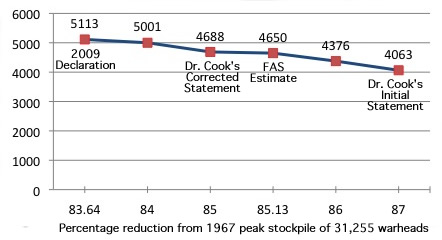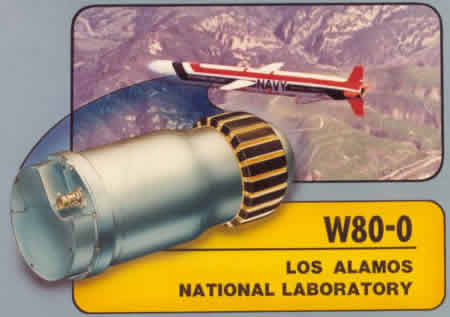(Still) Secret US Nuclear Weapons Stockpile Reduced

The United States has unilaterally reduced the size of its nuclear weapons stockpile by nearly 500 warheads since 2009.
By Hans M. Kristensen
The United States has quietly reduced its nuclear weapons stockpile by nearly 500 warheads since 2009. The current stockpile size represents an approximate 85-percent reduction compared with the peak size in 1967, according to information provided to FAS by the National Nuclear Security Administration (NNSA).
The reduction is unilateral and not required by any arms control treaty. It apparently includes retirement of warheads for the last non-strategic naval nuclear weapon, the nuclear Tomahawk land-attack cruise missile (TLAM/N).
85 Versus 87
One of the interesting moments at the Deterrence Summit last week came when Dr. Donald Cook, who is NNSA’s administrator for defense programs, talked about the size of the U.S. nuclear weapons stockpile.
At one point, Dr. Cook said that there are “roughly 5,000” warheads in the stockpile today. And then he added: “Today it’s, I’ll just say it’s a bit under about 5,000…about an 87 percent reduction” compared with the peak in 1967. (The 87 percent statements occurs 2:52:25 into the CSPAN recording).
Since the peak size of the stockpile has been declassified (31,255 warheads in 1967), an 87 percent reduction would in fact be quite a bit under 5,000 – a stockpile of 4,063 warheads, to be precise. If so, the stockpile would have shrunk by 1,050 warheads since September 2009 when the stockpile contained 5,113 warheads.
The number didn’t fit the stockpile estimate that Norris and I currently have (4,650 warheads), so I contacted Dr. Cook to double check if he meant to say 87 percent. He told me that it was an error and that the correct figure was “approximately 85% reduction.” That corresponds to a stockpile of roughly 4,688 warheads (depending on how many digits “approximately” implies), or about 38 warheads off our estimate of 4,650 warheads.
The warheads retired since 2009 apparently include the W80-0 warhead previously used on the nuclear Tomahawk land-attack cruise missile (TLAM/N). The 2010 Nuclear Posture Review decided the weapon was no longer needed, and “a very substantial number of W80-0″ warheads already have been dismantled, Dr. Cook told Congress last week. [Update 21 Mar: FY12 Pantex Performance Evaluation Report states (p.24): “All W80-0 warheads in the stockpile have been dismantled.” (Thanks Jay!)].
 |
| The last remaining U.S. non-strategic naval nuclear weapon – the Tomahawk land-attack cruise missile (TLAM/N – appears to have been retired in accordance with the 2010 Nuclear Posture Review determination that the weapon is no longer needed. |
.
Implications
Why is the size of the stockpile an issue? Well, first, because the Obama administration in 2010 declassified the 64-year history of the stockpile from 1945 through September 2009 because, as the Pentagon explained at the time, increasing transparency is important for U.S. nonproliferation efforts and additional arms reductions beyond the New START treaty. In his briefing, Dr. Cook also pointed to the importance of transparency.
Second, the size of the stockpile is important because although the administration has declassified 64 years of its history, its current size is – yes, you guessed it – still a secret. In fact, officials have told us that the 2010 disclosure was a one-time decision, not something that would be updated each year. So all stockpile numbers after September 2009 are still secret. Deep in the dark corridors of the Pentagon there are still people who believe this is necessary for national security.
Third, the unilateral retirement of roughly 500 warheads from the stockpile since 2009 – an inventory comparable to the total stockpiles of China and Britain combined – is political dynamite (no pun intended) because conservative Cold Warriors in Congress (and elsewhere) vehemently oppose unilateral reductions of U.S. nuclear weapons. Their argument is (as best I can gauge) that Russia and China are modernizing their nuclear weapons, and North Korea has just conducted a nuclear test. Therefore, so the thinking goes, it would somehow be detrimental to U.S. national security to unilaterally reduce its nuclear weapons.
The argument is, of course, deeply flawed because the reductions that Dr. Cook describe are warheads that the military has decided it no longer needs to meet presidential guidance for maintaining a strong nuclear deterrent in support of national security and reassurance of allies. Similar unilateral adjustments of the stockpile have been made by both Republican and Democratic administrations in the past.
The saga about stockpile classification and declassification is also important because it exemplifies a deeply schizophrenic policy. On the one hand, the administration has declassified decades worth of formerly secret stockpile information, emphasizes the continued importance of nuclear weapons transparency to support nonproliferation and arms control efforts, and urges other nuclear weapons states to be more open about their arsenals. At the same time, the administration continues to keep secret the current size of the stockpile, which, among other effects, forces officials such as Dr. Cook to be unnecessarily vague about the extent to which the United States continues to make progress on reducing nuclear weapons in compliance with its obligations under the nuclear Non-Proliferation Treaty.
Recommendations
If the administration believes that nuclear transparency is important, then it must continue to disclose stockpile numbers and avoid drifting back into automatic nuclear secrecy. It should also declassify how many weapons are dismantled each year and how many retired warheads are in storage awaiting dismantlement.
The Pentagon said in 2010 that it was looking at declassifying the number of weapons awaiting dismantlement, but so far nothing has happened.
The Nuclear Posture Review stated in 2010: “Today, there are several thousand nuclear warheads awaiting dismantlement, and this number will increase as weapons are removed from the stockpile under New START.” Actually, the New START Treaty does not require that nuclear warheads be removed from the stockpile, but the military will nonetheless probably retire the roughly 500 warheads assigned to the 48 SLBMs and 50 ICBMs that will be retired under the treaty.
We estimate that “several thousand” currently means about 3,000 retired warheads, and that 300-400 warheads are dismantled each year.
Declassification of the back-end (dismantlement numbers) of the nuclear posture goes hand in hand with declassification of the front-end (stockpile size) because dismantlement numbers prove that the United States is actually getting rid of the weapons and not just putting them in storage. That is the key message that unnecessary secrecy prevents U.S. officials from being able to convey to the international nonproliferation community.
This publication was made possible by a grant from the Ploughshares Fund. The statements made and views expressed are solely the responsibility of the author.
Satellite imagery has long served as a tool for observing on-the-ground activity worldwide, and offers especially valuable insights into the operation, development, and physical features related to nuclear technology.
This report outlines a framework relying on “Cooperative Technical Means” for effective arms control verification based on remote sensing, avoiding on-site inspections but maintaining a level of transparency that allows for immediate detection of changes in nuclear posture or a significant build-up above agreed limits.
The grant comes from the Carnegie Corporation of New York (CCNY) to investigate, alongside The British American Security Information Council (BASIC), the associated impact on nuclear stability.
Satellite imagery of RAF Lakenheath reveals new construction of a security perimeter around ten protective aircraft shelters in the designated nuclear area, the latest measure in a series of upgrades as the base prepares for the ability to store U.S. nuclear weapons.